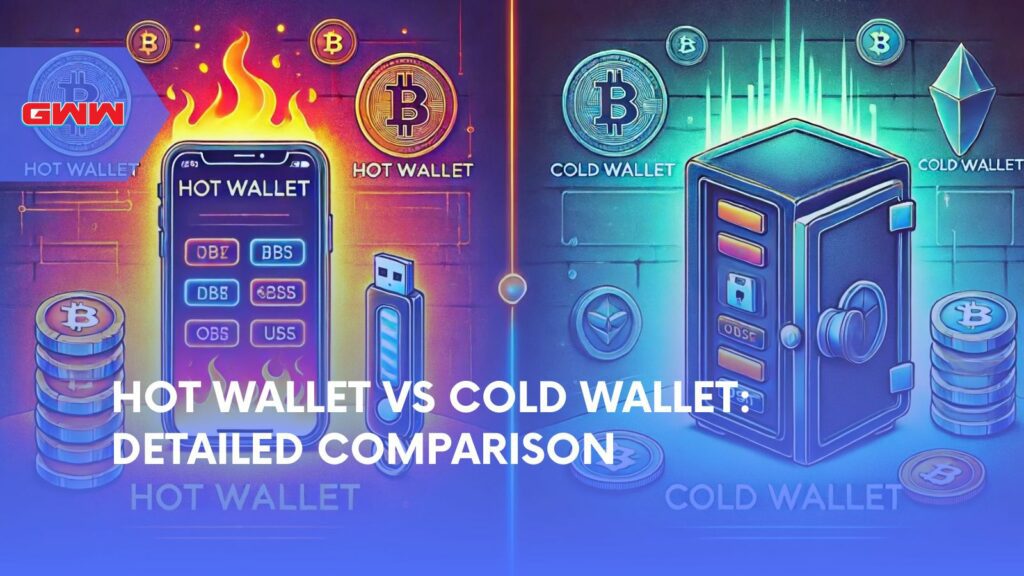
Cryptocurrency wallets are essential tools for managing digital assets, but choosing the right type can be confusing. Hot wallets and cold wallets each offer unique advantages and drawbacks, affecting security and convenience. Understanding the differences between these wallets is crucial for anyone involved in the cryptocurrency space.
This article explores the distinctions, benefits, and limitations of hot and cold wallets to help you make an informed decision on the best option for your needs. Dive in to learn which wallet suits your crypto strategy.
About Hot Wallet vs Cold Wallet
Definition of Hot Wallets
Hot wallets are digital wallets connected to the internet, making them easily accessible for frequent transactions. These wallets are typically software-based, allowing users to manage their cryptocurrency on computers or mobile devices. Hot wallets are known for their convenience, enabling quick access to funds for trading or spending.
Examples of hot wallets include:
- Metamask: A popular Ethereum wallet that integrates with decentralized applications.
- Coinbase Wallet: A user-friendly wallet associated with the Coinbase exchange.
- Trust Wallet: A versatile wallet that supports multiple cryptocurrencies.
While hot wallets offer ease of use, they are more susceptible to hacking and cyber-attacks due to their constant internet connectivity. Therefore, they are best suited for holding smaller amounts of cryptocurrency intended for regular transactions.
Definition of Cold Wallets
Cold wallets, also known as cold storage, are physical devices or offline software used to store cryptocurrency securely. Unlike hot wallets, cold wallets are not connected to the internet, significantly reducing the risk of cyber threats. These wallets are ideal for long-term storage of large amounts of cryptocurrency.
Examples of cold wallets include:
- Hardware Wallets: Devices like Ledger Nano S and Trezor that securely store private keys offline.
- Paper Wallets: Printed sheets containing a user’s private and public keys.
Cold wallets provide a higher level of security by keeping private keys offline, away from potential online vulnerabilities. However, they can be less convenient for everyday use due to the need for physical access to the device or document.
Which Is Better: Hot Wallet or Cold Wallet?
Security Comparison
When it comes to security, cold wallets are generally considered superior due to their offline nature. This isolation from the internet makes them less vulnerable to hacks, phishing attacks, and malware. However, they are not entirely foolproof and can still be compromised through physical theft or damage.
In contrast, hot wallets, while convenient, are more exposed to online threats. Users must be vigilant about security practices, such as enabling two-factor authentication and using strong, unique passwords.
Security Pros and Cons:
Hot Wallets:
- Pros: Convenient for daily transactions, quick access.
- Cons: Higher risk of cyber-attacks, requires constant security measures.
Cold Wallets:
- Pros: Superior security, ideal for long-term storage.
- Cons: Less convenient, requires physical access for transactions.
Usability and Convenience
Hot wallets excel in usability and convenience, providing immediate access to funds. This makes them perfect for active traders or individuals who frequently use cryptocurrency for purchases. The intuitive interfaces and integration with various online services enhance their practicality.
Cold wallets, while secure, are less user-friendly for everyday transactions. Accessing funds stored in a cold wallet typically involves more steps, such as connecting a hardware wallet to a computer or retrieving keys from a secure location. This makes them more suitable for long-term investors who prioritize security over convenience.
Usability Pros and Cons:
Hot Wallets:
- Pros: Easy to use, accessible from anywhere with an internet connection.
- Cons: Requires ongoing security vigilance, less secure.
Cold Wallets:
- Pros: High security for storage, protects against online threats.
- Cons: Cumbersome for frequent transactions, physical storage risks.
Is Metamask a Hot or Cold Wallet?
Metamask is a widely used cryptocurrency wallet that operates as a browser extension and mobile application. It allows users to manage their Ethereum and ERC-20 tokens seamlessly while interacting with decentralized applications (dApps). Metamask is known for its user-friendly interface and integration with popular browsers like Chrome and Firefox.
Key Features of Metamask:
- Supports Ethereum and ERC-20 tokens.
- Integrates with decentralized applications (dApps).
- Offers a built-in swap feature for easy token exchange.
- Provides security measures like password protection and seed phrases.
Classification
Metamask is classified as a hot wallet because it requires an internet connection to function. This connectivity facilitates quick and easy access to funds, making it a convenient option for users who frequently engage with dApps or need to perform regular transactions.
Why Metamask is a Hot Wallet:
- Online Connectivity: Operates via internet browsers and mobile apps.
- Frequent Use: Designed for regular transactions and interaction with dApps.
- Security Measures: Implements standard security protocols for online wallets, but still relies on user vigilance to avoid phishing and hacking risks.
Metamask offers significant convenience and utility, users should be aware of the inherent risks associated with hot wallets and take appropriate measures to secure their assets.
Is Coinbase a Hot or Cold Wallet?
Coinbase is one of the most popular cryptocurrency exchanges in the world, offering a wide range of services including buying, selling, and storing digital assets. Coinbase provides both a user-friendly platform for beginners and advanced tools for experienced traders. One of its key features is the Coinbase Wallet, which allows users to manage their cryptocurrencies securely.
Key Features of Coinbase:
- Wide Range of Cryptocurrencies: Supports many different digital assets.
- User-Friendly Interface: Easy to navigate for beginners.
- Integrated Exchange: Seamless integration with the Coinbase exchange.
- Security Features: Includes two-factor authentication and insurance against certain types of breaches.
Classification
Coinbase Wallet is considered a hot wallet. This is because it is an online wallet, meaning it is connected to the internet and accessible through web browsers and mobile applications. While this makes Coinbase Wallet highly convenient for transactions and easy access, it also exposes it to potential online threats.
Why Coinbase is a Hot Wallet:
- Online Connectivity: Accessible via the internet for quick transactions.
- Integration with Exchange: Facilitates easy buying, selling, and trading.
- Security Measures: Employs standard security protocols but still vulnerable to internet-based threats.
What Are the Disadvantages of a Cold Wallet?
Cold wallets, while highly secure, come with certain accessibility challenges. Since they are not connected to the internet, accessing funds stored in a cold wallet requires physical interaction with the device. This can be cumbersome, especially for users who need to access their funds frequently.
Accessibility Challenges:
- Physical Access Required: Must have the device on hand to access funds.
- Time-Consuming: Additional steps needed to connect and authenticate.
- Limited Use Cases: Not ideal for quick transactions or active trading.
Potential Risks
Despite their security benefits, cold wallets are not without risks. Physical cold wallets, such as hardware wallets, can be lost, stolen, or damaged. Additionally, users must ensure they store their recovery phrases in a secure location, as losing this information can result in permanent loss of access to their funds.
Risks of Cold Wallets:
- Physical Theft or Loss: Risk of losing the device or having it stolen.
- Damage: Devices can be damaged by physical impact or environmental factors.
- Complexity: Setting up and using a cold wallet can be more complex compared to hot wallets.
Is Binance a Hot or Cold Wallet?
Binance is a leading global cryptocurrency exchange known for its wide range of supported cryptocurrencies and advanced trading features. Binance offers a variety of services, including spot trading, futures trading, staking, and its own Binance Wallet, which users can use to store their digital assets securely.
Key Features of Binance:
- Extensive Cryptocurrency Support: Wide selection of supported coins and tokens.
- Advanced Trading Tools: Features for both beginner and professional traders.
- Security Measures: Includes two-factor authentication, withdrawal whitelist, and cold storage for a significant portion of user funds.
Classification
The Binance Wallet is considered a hot wallet. It is connected to the internet, allowing users to access their funds quickly for trading and other transactions. However, Binance also employs cold storage techniques to enhance the security of a large portion of its users’ funds.
Why Binance is a Hot Wallet:
- Online Accessibility: Allows for quick and convenient access to funds for trading.
- Integrated Services: Directly linked to the Binance trading platform for seamless transactions.
- Security Protocols: Utilizes a combination of hot wallet convenience and cold storage security.
Binance offers robust security features and a blend of hot and cold storage techniques, users should still practice good security hygiene, such as enabling two-factor authentication and regularly updating their passwords.
Is Cold Wallet 100% Safe?
Cold wallets are highly secure because they are offline, significantly reducing the risk of hacking and cyber-attacks. By storing private keys offline, they offer robust protection against online threats. However, no security measure is completely foolproof.
Key Security Features:
- Offline Storage: Private keys are not exposed to the internet.
- Physical Security: Devices like hardware wallets require physical access.
- Encryption: Advanced encryption methods protect stored data.
User Responsibility
While cold wallets provide strong security, their safety ultimately depends on user practices. Users must ensure they protect their recovery phrases, avoid physical damage to the device, and be cautious of potential physical theft.
User Tips for Cold Wallet Safety:
- Store Recovery Phrases Securely: Keep backup phrases in a safe location.
- Avoid Physical Damage: Handle the device with care to prevent damage.
- Be Vigilant: Protect the device from theft and unauthorized access.
Overall, cold wallets offer excellent security, but users must remain diligent to maintain their safety.
Key Takeaways
Understanding the differences between hot and cold wallets is essential for managing cryptocurrency effectively. Each type of wallet offers unique benefits and potential drawbacks, depending on the user’s needs and preferences.
Hot Wallets:
- Convenience: Ideal for frequent transactions and active trading.
- Accessibility: Always connected to the internet for easy access.
- Security Risks: Higher vulnerability to cyber-attacks.
Cold Wallets:
- Security: Superior protection due to offline storage.
- Long-term Storage: Best for holding large amounts of cryptocurrency.
- Accessibility Issues: Requires physical access and more steps to use.
Choosing between a hot wallet and a cold wallet depends on your specific requirements. For daily transactions and ease of use, hot wallets are more suitable. For securing larger amounts of cryptocurrency with minimal transaction needs, cold wallets are the better option. Combining both types can provide a balanced approach to cryptocurrency security and convenience.
FAQs
What is the main difference between a hot wallet and a cold wallet?
Hot wallets are connected to the internet for easy access and frequent transactions, while cold wallets are offline, providing higher security for long-term storage.
Can I use both hot and cold wallets?
Yes, using both allows you to enjoy the convenience of hot wallets for daily use and the security of cold wallets for long-term storage.
How do I decide which wallet type to use?
If you need frequent access to your cryptocurrency, choose a hot wallet. For secure, long-term storage, go with a cold wallet.
What are some popular examples of hot wallets?
Popular hot wallets include Metamask, Coinbase Wallet, and Trust Wallet.
What are some popular examples of cold wallets?
Common cold wallets include hardware wallets like Ledger Nano S and Trezor, as well as paper wallets.


